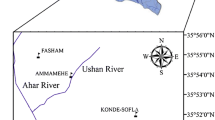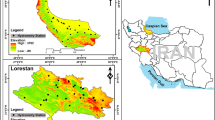Abstract
Accurate estimation of suspended sediment is important for water resources projects. The accuracy of local weighted linear regression (LWLR) technique is investigated in this study for modeling streamflow-suspended sediment relationship. Daily data from two stations on the Eel River in California were used in the applications. In the first part of the study, the LWLR results were compared with those of the least square support vector machine (LSSVM), artificial neural networks (ANNs) and sediment rating curve (SRC) for modeling sediment data of upstream and downstream stations, separately. Root mean square errors (RMSE), mean absolute errors (MAE) and determination coefficient (R2) statistics were used for comparison of the applied models Comparison results indicated that the LWLR model performed better than the LSSVM, ANN and SRC models. Accuracies of the sediment modeling increased by the LWLR model compared with the LSSVM model: 14 % (60 %) and 33 % (42 %) decrease in the RMSE (MAE) values for the upstream and downstream stations, respectively. The second part of the study focused on the comparison of the models in estimating downstream suspended sediment data by using data from both stations. LWLR was found to be better than the LSSVM, ANN and SRC models. The RMSE accuracy of the LSSVM model was increased by 39 % using the LWLR model.












Similar content being viewed by others
References
Adamowski J, Karapataki C (2010) Comparison of multivariate regression and artificial neural networks for peak urban water-demand forecasting: evaluation of different ANN learning algorithms. J Hydrol Eng 15(10):729–743
Agarwal A, Mishra SK, Ram S, Singh JK (2006) Simulation of runoff and sediment yield using artificial neural networks. Biosyst Eng 94(4):597–613
Alikhani A (2009) Combination of neuro fuzzy and wavelet model usage in river engineering. Int J Energy Environ 3(3):122–134
Allison PD (1998) Multiple regression: a primer. Pine forge Press
Alp M, Cigizoglu H (2007) Suspended sediment load simulation by two artificial neural network methods using hydrometeorological data. Environ Model Softw 22(1):2–13
Aydogdu M, Firat M (2015) Estimation of failure rate in water distribution network using fuzzy clustering and LS-SVM methods. Water Resour Manag 29(5):1575–1590
Barnett WA, Powell J, Tauchen GE (1991) Nonparametric and semiparametric methods in econometrics and statistics. Cambridge University Press, New York
Baylar A, Hanbay D, Batan M (2009) Application of least square support vector machines in the prediction of aeration performance of plunging overfall jets from weirs. Expert Syst Appl 36(4):8368–8374
Bhattacharya B, Price RK, Solomatine DP (2005) Data-driven modelling in the context of sediment transport. Phys Chem Earth 30(4–5):297–302
Casetti E (1997) The expansion method, mathematical modeling, and spatial econometrics. Int Reg Sci Rev 20:9–32
Cigizoglu HK (2004) Estimation and forecasting of daily suspended sediment data by multi-layer perceptrons. Adv Water Resour 27(2):185–195
Cigizoglu HK, Kisi O (2006) Methods to improve the neural network performance in suspended sediment estimation. J Hydrol 317(3–4):221–238
Clark MP, Slater AG (2006) Probabilistic quantitative precipitation estimation in complex terrain. J Hydrometeorol 7:3–22
Cleveland WS (1979) Robust locally weighted regression and smoothing scatterplots. J Am Stat Assoc 74:829–36
Cleveland WS, Devlin SJ (1988) Locally weighted regression: an approach to regression analysis by local fitting. J Am Stat Assoc 83:596–610
Cutore, PI Mauro GD, Cancelliere A (2009) Forecasting palmer index using neural networks and climatic indexes. J Hydrol Eng 10.1061/(ASCE)HE.1943-5584.0000028, 588–595
Daly C, Neilson RP, Phillips DL (1994) A statistical-topographic model for mapping climatological precipitation over mountainous terrain. J Appl Meteorol 33:140–158
Fahimi F, El-Shafie AH (2014) Comment on “a hybrid model of self organizing maps and least square support vector machine for river flow forecasting” by Ismail et al. (2012). Hydrol Earth Syst Sci 18(7):2711–2714
Fan J, Gijbels I (1996) Local polynomial modelling and its applications. Chapman & Hall, London
Fotheringham AS, Brunsdon C, Charlton M (2000) Quantitative geography: perspectives on spatial analysis. Sage, London
Fotheringham AS, Charlton ME, Brunsdon C (2001) Spatial variations in school performance: a local analysis using geographically weighted regression. Geogr Environ Model 5:43–66
Fotheringham AS, Brunsdon C and Charlton M (2002) Geographically weighted regression: the analysis of spatially varying relationships. Wiley
Fox J (2000a) Nonparametric simple regression. Thousand Oaks, CA, Sage
Fox J (2000b) Multiple and generalized nonparametric regression. Thousand Oaks, CA, Sage
Friedman JH (1991) Multivariate adaptive regression splines (with discussion). Ann Stat 19:1–141
Green PJ, Silverman BW (1994) Nonparametric regression and generalized linear models: a roughness penalty approach. Chapman & Hall, London
Hanbay D, Baylar A, Batan M (2009) Prediction of aeration efficiency on stepped cascades by using least square support vector machines. Expert Syst Appl 36(3):4248–4252
Hardle W (1990) Applied nonparametric regression. Cambridge University Press, New York
Ismail S, Shabri A, Samsudin R (2012) A hybrid model of self organizing maps and least square support vector machine for river flow forecasting. Hydrol Earth Syst Sci 16(11):4417–4433
Kalteh AM (2016) Improving forecasting accuracy of streamflow time series using least squares support vector machine coupled with data-preprocessing techniques 30(2): 747–766
Klausner A, Tengg A, Rinner B (2007) Vehicle classification on multi-sensor smart cameras using feature- and decision-fusion. In: Proceedings of the First ACM/IEEE International Conference on Distributed Smart Cameras (ICDSC-07), p 67–74
Kisi Ö (2008) Constructing neural network sediment estimation models using a data-driven algorithm. Math Comput Simul 79(1):94–103
Kisi O (2012) Modeling discharge-suspended sediment relationship using least square support vector machine. J Hydrol 456:110–120
Kisi O, Yuksel I, Dogan E (2008) Modelling daily suspended sediment of rivers in Turkey using several data-driven techniques. Hydrol Sci J 53(6):1270–1285
Kitsikoudis V, Sidiropoulos E, Hrissanthou V (2014) Machine learning utilization for bed load transport in gravel-bed rivers. Water Resour Manag 28(11):3727–3743
Kuh A (2004) “Least squares kernel methods and applications.” Chapter 17, Soft computing in communications. Springer, Berlin, pp 365–387
Kumar M, Kar IN (2002) Non-linear HVAC computations using least square support vector machines. Energy Convers Manag 50:1411–1418
Kutner MH, Nachtsheim CJ, Neter J, Li W (2005) Applied linear statistical models, 5th edn. McGraw-Hill/Irwin, New York
Loader C (1999) Local regression and likelihood. Springer, New York
Md Ghani IM, Ahmad S (2010) Stepwise multiple regression method to forecast fish landing. Procedia Soc Behav Sci 8:549–554
Mustafa MR, Rezaur RB, Saiedi S, Isa MH (2012) River suspended sediment prediction using various multilayer perceptron neural network training algorithms—a case study in Malaysia. Water Resour Manag 26(7):1879–1897
Rajagopalan B, Lall U (1998) Locally weighted polynomial estimation of spatial precipitation. J Geogr Inf Decis Anal 2:44–50
Rencher AC and Schaalje GB (2008) Linear models in statistics. 2nd edn. Wiley
Sachindra DA, Huang F, Barton A, Perera BJC (2013) Least square support vector and multi-linear regression for statistically downscaling general circulation model outputs to catchment streamflows. Int J Climatol 33(5):1087–1106
Shabri A, Suhartono (2012) Streamflow forecasting using least-squares support vector machines. Hydrol Sci J 57(7):1275–1293
Sivakumar B, Wallender WW (2005) Predictability of river flow and suspended sediment transport in the Mississippi River basin: a non-linear deterministic approach. Earth Surf Process Landf 30(6):665–677
Suykens JAK, Vandewalle J (1999) Least square support vector machine classifiers. Neural Process Lett 9(3):293–300
Tabari H, Kisi O, Ezani A, Hosseinzadeh Talaee P (2012) SVM, ANFIS, regression and climate based models for reference evapotranspiration modeling using limited climatic data in a semi-arid highland environment. J Hydrol 444:78–89
Thorsnes P, McMillen D (1998) Land value and parcel size: a semiparametric analysis. J Real Estate Financ Econ 17:233–44
Tu JV (1996) Advantages and disadvantages of using artificial neural networks versus logistic regression for predicting medical outcomes. J Clin Epidemiol 49(11):1225–1231
van Maanen B, Coco G, Bryan KR, Ruessink BG (2010) The use of artificial neural networks to analyze and predict alongshore sediment transport. Nonlinear Process Geophys 17(5):395–404
Wand MP, Jones MC (1995) Kernel smoothing. Chapman & Hall, London
Acknowledgements
The data used in this study were downloaded from the web server of the USGS. The author would like to thank the personnels of the USGS who are associated with data observation, processing, and management of USGS Web sites.
Author information
Authors and Affiliations
Corresponding author
Additional information
An erratum to this article is available at http://dx.doi.org/10.1007/s11269-016-1551-z.
Rights and permissions
About this article
Cite this article
Kisi, O., Ozkan, C. A New Approach for Modeling Sediment-Discharge Relationship: Local Weighted Linear Regression. Water Resour Manage 31, 1–23 (2017). https://doi.org/10.1007/s11269-016-1481-9
Received:
Accepted:
Published:
Issue Date:
DOI: https://doi.org/10.1007/s11269-016-1481-9




